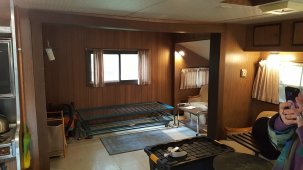So y'all have me leaning to a single system with a step-down for the 12v. OK. I was thinking about my last power audit and I had another thought. I need 50a of 12v at full load, 300w for lights/tv/fans, 300w for the coffee pot, and I'd like to add in a 12k BTU 120v air conditioner at about 1100w. By my rough math that puts me at 1700w worst case scenario on the AC line, plus my electric fridge that I got after my last power audit and can't find power info on. Now, the odds of needing all that power at the same time are slim to none since I'm not going to be starting up all 3 heaters and firing up the aircon at the same time, but it gives me a power envelope to work with.
Here's a thought that popped in my head, and please poke holes in it:
MPP LV2424 MSD inverter AIO for about $700
Uxcell 24v -> 12v 70a converter for about $80
2x 120Ah deep cycle FLA batteries for about $200
AiLi Shunt for about $50
125a DC Breaker for about $25
12-slot DC Fuse Block for about $20
1200w-ish of panels to the AIO
400w-ish of panels to old MPPT
Not counting wire and the panels I've got in another budget column, that comes out to $1075-ish which is within margin budget.
I can put 6 panels to the SCC in a 3s2p and an additional 2 panels in series to the old MPPT controller I'll be recycling to keep the batteries topped up while the system is disconnected for the 6-8 months at a time I'm overseas.
I'll use the existing 4 batteries I have and get 2 more of the same in a 2s/3p 24v config which should get me about 180Ah of usable power.
I'm thinking the startup procedure would be something like:
Step 1: Hold Precharge button for (X-time)
Step 2: Turn on battery breaker
Step 3: Turn on Big White MPP Box
Step 4: Party
OK Guys, start poking holes! While yes the 48v system would be smaller wires, I only have physical space for 6 batteries so I can have a 60Ah@48v OR 180Ah@24v. Stupid physics! Same with the panels. I might be able to stick another string of panels out there but the open space I have I'm pretty sure limits me to 3 racks total and my old MPPT can't take a 3s panel set without catching on fire.




